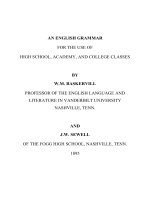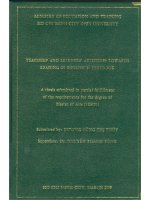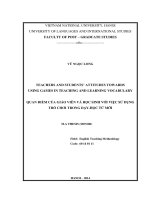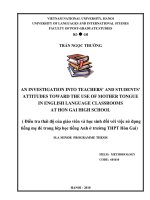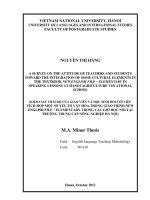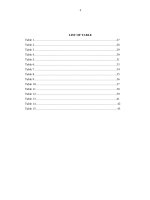A survey on urban high school teachers and students attitudes towards communicative language teaching
Bạn đang xem bản rút gọn của tài liệu. Xem và tải ngay bản đầy đủ của tài liệu tại đây (107.34 KB, 4 trang )
Vietnam National University, Hanoi
University of Languages and International Studies
FACULTY OF Post- graduate STUDIES
VŨ THỊ HOÀNG ANH
A SURVEY ON URBAN HIGH SCHOOL TEACHER’S AND
STUDENTS’ ATTITUDES TOWARDS COMMUNICATIVE
LANGUAGE TEACHING
KHẢO SÁT THÁI ĐỘ CỦA GIÁO VIÊN VÀ HỌC SINH TRUNG HỌC
NỘI THÀNH VỀ VIỆC DẠY HỌC THEO ĐƯỜNG HƯỚNG GIAO TIẾP
M.A. COMBINED PROGRAMME THESIS
FIELD: METHODOLOGY
CODE: 601410
HA NOI, 2010
Vietnam National University, Hanoi
University of Languages and International Studies
FACULTY OF Post- graduate STUDIES
VŨ THỊ HOÀNG ANH
A SURVEY ON URBAN HIGH SCHOOL TEACHER’S AND
STUDENTS’ ATTITUDES TOWARDS COMMUNICATIVE
LANGUAGE TEACHING
KHẢO SÁT THÁI ĐỘ CỦA GIÁO VIÊN VÀ HỌC SINH TRUNG HỌC
NỘI THÀNH VỀ VIỆC DẠY HỌC THEO ĐƯỜNG HƯỚNG GIAO TIẾP
M.A. COMBINED PROGRAMME THESIS
FIELD: METHODOLOGY
CODE: 601410
SUPERVISOR: LÊ VĂN CANH M.A
HA NOI, 2010
5
TABLE OF CONTENTS
Page
PART I: INTRODUCTION................................................................................................................... 1
1.1. Rationale............................................................................................................................................ 1
1.2. Aims................................................................................................................................................... 2
1.3. Objectives......................................................................................................................................... 2
1.4. Research questions.......................................................................................................................... 3
1.5. Scope.................................................................................................................................................. 3
1.6. Research methodology................................................................................................................... 3
1.7. Significance of the study............................................................................................................... 4
1.8. Structure of the thesis..................................................................................................................... 4
PART II: DEVELOPMENT.................................................................................................................. 6
CHAPTER I: LITERATURE REVIEW............................................................................................ 6
1.1. The main characteristics of the Communicative Language Teaching (CLT)……..…6
1.2. Definition of communicative language teaching (CLT)…………………………....10
1.3. Defining communicative competence……………………………………………....12
1.4. Techniques for CLT………………………………………………………………..13
1.5. Benefits of CLT…………………………………………………………………….14
1.6. Challenges of CLT …….…………………………………………………………..15
1.7. Some misconceptions about CLT ………………………………………………....16
1.8. Roles of Teachers in CLT ………………………………………………………….18
1.9. Teachers’ and students’ attitudes towards CLT………………………………….....19
1.10. Summary………………………………………………………………………….22
CHAPTER II:
STUDY……………………………………………………………………………...........23
2.1. The context of the study ………………………………………………………..….23
2.2. Participants………………………………………………………………………. . .24
2.3. Instruments for Data Collection ………………………………………………..….24
6
2.4. Data Analysis ……………………………………………………………………….26
2.5. Findings……………………………………………………………………………..27
2.6. Teachers’ Attitudes and Classroom Practices ……………………………………...45
CHAPTER III: DISCUSSION………………………………………………………….49
3.1. Teachers’ and students’ attitudes towards CLT…………………………………….49
3.2. The influence of teachers’ attitudes on their classroom teaching…………………..50
PART III: THE CONCLUSION………………………………………………………. 51
1. Summary……..…………………………………………………………………………51
2. Implications for Teacher Education…………………………………………………….51
3. Limitations of the study…………………………………………………………………52
4. Suggestions for Further Studies …………………………………………………...…...52
REFERENCES……………………………………………………………………..……53
APPENDICES
